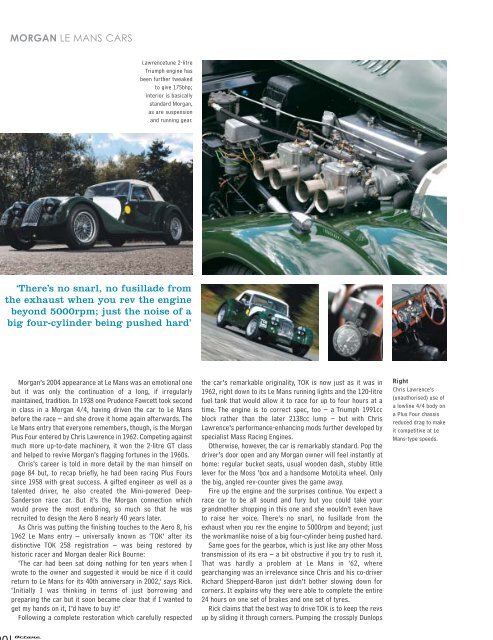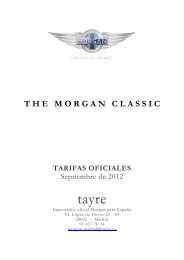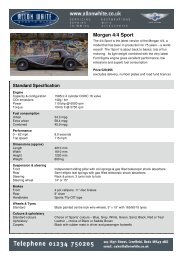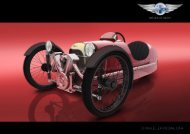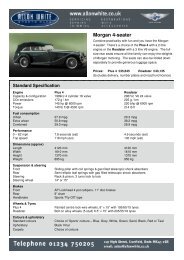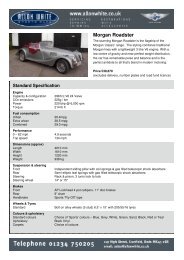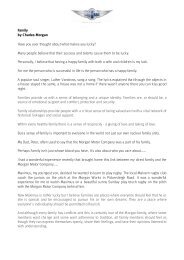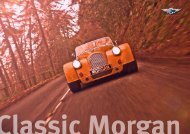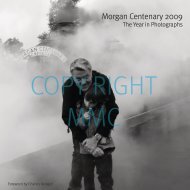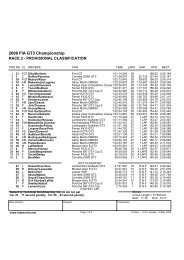MORGAN LE MANS CARS - The Morgan Motor Company
MORGAN LE MANS CARS - The Morgan Motor Company
MORGAN LE MANS CARS - The Morgan Motor Company
You also want an ePaper? Increase the reach of your titles
YUMPU automatically turns print PDFs into web optimized ePapers that Google loves.
80<br />
<strong>MORGAN</strong> <strong>LE</strong> <strong>MANS</strong> <strong>CARS</strong><br />
12 04<br />
Lawrencetune 2-litre<br />
Triumph engine has<br />
been further tweaked<br />
to give 175bhp;<br />
interior is basically<br />
standard <strong>Morgan</strong>,<br />
as are suspension<br />
and running gear.<br />
‘<strong>The</strong>re’s no snarl, no fusillade from<br />
the exhaust when you rev the engine<br />
beyond 5000rpm; just the noise of a<br />
big four-cylinder being pushed hard’<br />
<strong>Morgan</strong>’s 2004 appearance at Le Mans was an emotional one<br />
but it was only the continuation of a long, if irregularly<br />
maintained, tradition. In 1938 one Prudence Fawcett took second<br />
in class in a <strong>Morgan</strong> 4/4, having driven the car to Le Mans<br />
before the race – and she drove it home again afterwards. <strong>The</strong><br />
Le Mans entry that everyone remembers, though, is the <strong>Morgan</strong><br />
Plus Four entered by Chris Lawrence in 1962. Competing against<br />
much more up-to-date machinery, it won the 2-litre GT class<br />
and helped to revive <strong>Morgan</strong>’s flagging fortunes in the 1960s.<br />
Chris’s career is told in more detail by the man himself on<br />
page 84 but, to recap briefly, he had been racing Plus Fours<br />
since 1958 with great success. A gifted engineer as well as a<br />
talented driver, he also created the Mini-powered Deep-<br />
Sanderson race car. But it’s the <strong>Morgan</strong> connection which<br />
would prove the most enduring, so much so that he was<br />
recruited to design the Aero 8 nearly 40 years later.<br />
As Chris was putting the finishing touches to the Aero 8, his<br />
1962 Le Mans entry – universally known as ‘TOK’ after its<br />
distinctive TOK 258 registration – was being restored by<br />
historic racer and <strong>Morgan</strong> dealer Rick Bourne:<br />
‘<strong>The</strong> car had been sat doing nothing for ten years when I<br />
wrote to the owner and suggested it would be nice if it could<br />
return to Le Mans for its 40th anniversary in 2002,’ says Rick.<br />
‘Initially I was thinking in terms of just borrowing and<br />
preparing the car but it soon became clear that if I wanted to<br />
get my hands on it, I’d have to buy it!’<br />
Following a complete restoration which carefully respected<br />
the car’s remarkable originality, TOK is now just as it was in<br />
1962, right down to its Le Mans running lights and the 120-litre<br />
fuel tank that would allow it to race for up to four hours at a<br />
time. <strong>The</strong> engine is to correct spec, too – a Triumph 1991cc<br />
block rather than the later 2138cc lump – but with Chris<br />
Lawrence’s performance-enhancing mods further developed by<br />
specialist Mass Racing Engines.<br />
Otherwise, however, the car is remarkably standard. Pop the<br />
driver’s door open and any <strong>Morgan</strong> owner will feel instantly at<br />
home: regular bucket seats, usual wooden dash, stubby little<br />
lever for the Moss ’box and a handsome MotoLita wheel. Only<br />
the big, angled rev-counter gives the game away.<br />
Fire up the engine and the surprises continue. You expect a<br />
race car to be all sound and fury but you could take your<br />
grandmother shopping in this one and she wouldn’t even have<br />
to raise her voice. <strong>The</strong>re’s no snarl, no fusillade from the<br />
exhaust when you rev the engine to 5000rpm and beyond; just<br />
the workmanlike noise of a big four-cylinder being pushed hard.<br />
Same goes for the gearbox, which is just like any other Moss<br />
transmission of its era – a bit obstructive if you try to rush it.<br />
That was hardly a problem at Le Mans in ’62, where<br />
gearchanging was an irrelevance since Chris and his co-driver<br />
Richard Shepperd-Baron just didn’t bother slowing down for<br />
corners. It explains why they were able to complete the entire<br />
24 hours on one set of brakes and one set of tyres.<br />
Rick claims that the best way to drive TOK is to keep the revs<br />
up by sliding it through corners. Pumping the crossply Dunlops<br />
Right<br />
Chris Lawrence’s<br />
(unauthorised) use of<br />
a lowline 4/4 body on<br />
a Plus Four chassis<br />
reduced drag to make<br />
it competitive at Le<br />
Mans-type speeds.
‘In 1962, changing gear was an irrelevance since Chris Lawrence<br />
and his co-driver just didn’t bother slowing down for corners; that’s<br />
why they were able to complete the race on one set of brakes’<br />
12 04<br />
81
82<br />
<strong>MORGAN</strong> <strong>LE</strong> <strong>MANS</strong> <strong>CARS</strong><br />
to 40psi helps, he says. But you don’t have to drive TOK like a<br />
loony to make rapid progress, because it handles beautifully.<br />
<strong>The</strong>re’s none of the squirminess usually associated with<br />
crossply-shod road cars when faced with a tight corner, and the<br />
steering has just the right combination of weight and feel. <strong>The</strong><br />
relatively stiff suspension means there’s negligible body roll<br />
and yet the ride never seems harsh. You really do feel that you<br />
could drive this car to Le Mans, do the race and drive home<br />
again, just as Ms Fawcett did in 1938.<br />
Chris Lawrence has his own theory about why TOK is such a<br />
good racer. ‘It’s a happy accident that old HFS [<strong>Morgan</strong>]’s front<br />
suspension locks up solid the moment it sees a corner, so<br />
creating a very stiff front end while the back remains flexible.<br />
It makes the chassis hideous on the road but great for racing.’<br />
Whereas TOK is basically a stock <strong>Morgan</strong> with a hot engine,<br />
you can’t say the same about the 2004 Aero 8 GT(N). While it’s<br />
closely related to the production car – it has to be, to meet the<br />
race regs for its class – it’s a much more specialised piece of<br />
kit. Driving the Le Mans Aero in traffic would be like trying to<br />
keep a tiger on the leash in a herd of wildebeest.<br />
<strong>Morgan</strong>’s first attempt with an Aero at Le Mans was in 2002<br />
with an American-sponsored DeWalt/RSS car but engine<br />
failure forced retirement after 18 hours. It was a heroic effort<br />
yet, for reasons known only to the Automobile Club de l’Ouest,<br />
<strong>Morgan</strong> were denied an entry to Le Mans in 2003. <strong>The</strong>y put the<br />
unexpected extra time to good use by testing a new car at Spa<br />
and Sebring, ready for their return to Le Mans in 2004.<br />
12 04<br />
Aero 8 GT(N) is now a<br />
catalogued production<br />
model; rear spoiler,<br />
odd-sized alloys and<br />
racing gearbox aside,<br />
it’s remarkably<br />
similar to ‘ordinary’<br />
roadgoing Aeros.<br />
‘A Le Mans-spec engine comes in at<br />
around £70,000 and is good for 30<br />
hours of racing before it has to be<br />
overhauled – which costs 30 grand’<br />
Taking in the GT(N)’s skeletal rear spoiler, limpet-like stance<br />
and rubber-band-shod alloys, you might expect it to be nothing<br />
more than a silhouette version of a regular Aero 8, all spaceframe<br />
and carbonfibre under the outer panels. In fact, the gearbox is<br />
the only completely different component. Peek inside the cockpit<br />
and you see not spaceframe, but wood frame. Reassuringly,<br />
alongside the fighter-jet display of push-button and toggle<br />
switches, there are also a couple of girlie pin-ups, to alleviate<br />
the drivers’ boredom during those endless circuits of La Sarthe.<br />
<strong>The</strong> elaborate switchgear is there to prolong the life of the<br />
racing engine, which is handbuilt by Swiss company Mader.<br />
A new unit comes in at around £70,000 and is good for about<br />
30 racing hours before it has to be sent back for overhaul; and<br />
since this particular engine has just gone through the<br />
‘refreshing’ process – which itself costs 30 grand – we’ve been<br />
asked, politely but firmly, not to exceed 3500rpm.<br />
Probably just as well, since the test track has a strict noise<br />
limit and one thing the Aero isn’t is quiet. <strong>The</strong> sound it makes is<br />
pure racer: harsh, metallic, and loud enough to make you wince<br />
if you’re standing nearby when someone blips the throttle. At<br />
fast idle, it has the manic energy of a thrash-metal guitarist.<br />
One of the three Aero drivers at Le Mans this year, Neil<br />
Cunningham, reckons the noise is the most tiring aspect of the<br />
GT(N). ‘Don’t get me wrong, it’s a fantastic sound and I love it,<br />
but it’s pretty deafening on the inside,’ the Kiwi-born Cunningham<br />
says. ‘That and the heatsoak from the running gear gets you<br />
tired. <strong>The</strong> steering’s heavy in the tigher corners, too.’<br />
Right<br />
Although fearsomely<br />
quick, Aero’s<br />
performance is<br />
severely restricted by<br />
Le Mans class regs –<br />
it could be made to go<br />
much faster.
‘Even at half-throttle you can glimpse what it must be like to hurtle<br />
down the Mulsanne at almost 190mph, fingers clenched around the<br />
Momo wheel and eardrums hammered by the V8’s relentless attack’<br />
Pulling maybe half the revs that Cunningham would have been using, I don’t have a<br />
problem with the steering, which seems direct without being at all twitchy. <strong>The</strong><br />
gearbox is an American-made Jerico racing unit so it’s tough as a Peterbilt truck and<br />
clutchless gearchanges are a cinch; just bang the lever through and don’t worry about it.<br />
Even at half-throttle you can glimpse what it must be like to hurtle down the<br />
Mulsanne at almost 190mph, buttocks clamped in the racing seat, fingers clenched<br />
around the thick-rimmed Momo wheel, eardrums hammered by the V8’s relentless<br />
attack. Sneak a couple of hundred rpm above the pre-ordained limit and a slight<br />
vibration permeates the alloy tub: you can almost sense the car readying itself for a<br />
new level of performance, like a cat shimmying its hindquarters as it prepares to leap.<br />
Back off the throttle slightly for an upchange and there’s a growl from deep in the<br />
car’s belly until you shove the gearlever home and the Aero springs forward again.<br />
But there’s a price to pay for such exuberance and on the next lap the test track’s<br />
traffic signals are showing red: we’re making too much noise to be allowed to<br />
continue. Kill the engine and silence falls like a heavy blanket over the circuit, to be<br />
punctuated only by the cooling tick of the Aero’s exhausts.<br />
One last question for the blokes from <strong>Morgan</strong>. I’m intrigued by the two red lenses<br />
on the back of the car, with their hallucinogenic swirly patterns. One is round and one<br />
is square: is this to meet some arcane detail of the Le Mans regulations?<br />
‘<strong>The</strong>y’re rain lamps,’ explains Dave, the electrician. ‘It turned out we had one of<br />
each type in the store – and it seemed a waste of money to buy another just so we’d<br />
have a matching pair.’<br />
That’s why we love <strong>Morgan</strong>s so much. Real cars, built by real people.<br />
Thanks to: Charles <strong>Morgan</strong>, Matthew Parkin, Mark Baldwin and Dave Bradley from <strong>Morgan</strong>; and Rick Bourne of Brands Hatch <strong>Morgan</strong>s (01732 882017).<br />
If you’d like your own Aero GT(N), <strong>Morgan</strong> are taking order. To follow the progress of the Le Mans car’s auction on eBay, go to www.ebay.com and<br />
set up a search facility for the words ‘<strong>Morgan</strong>’, ‘Le Mans’ and ‘2004’, using the automatic email facility to advise you when the auction starts.<br />
SPECIFICATION<br />
1962 <strong>Morgan</strong><br />
Plus Four<br />
Engine<br />
1991cc, four-cylinder,<br />
pushrod ohv, twin Weber<br />
42DCOE carbs,<br />
Lawrencetune manifolds<br />
Output<br />
175bhp @ 6300rpm<br />
160lb ft @ 5200rpm<br />
Transmission<br />
Four-speed manual<br />
Suspension<br />
Front: independent,<br />
sliding pillar, Koni shock<br />
absorbers. Rear: live<br />
axle, semi-elliptics,<br />
Koni shock absorbers<br />
Brakes<br />
Front: discs<br />
Rear: drums<br />
Weight<br />
815kg (1797lb)<br />
Performance<br />
Top speed: 125-148mph<br />
depending on gearing<br />
SPECIFICATION<br />
2004 <strong>Morgan</strong><br />
Aero 8 GT(N)<br />
Engine<br />
4498cc, all-alloy BMW<br />
V8, four overhead<br />
camshafts, 32 valves,<br />
Bosch fuel injection<br />
Output<br />
465bhp @ 6800rpm<br />
406lb ft @ 6300rpm<br />
Transmission<br />
Five-speed manual<br />
Suspension<br />
Front: cantilever upper<br />
arms, lower wishbones,<br />
coils over Öhlins shocks.<br />
Rear: coil-and-wishbone,<br />
Öhlins shock absorbers<br />
Brakes<br />
Ventilated, cross-drilled<br />
discs all round<br />
Weight<br />
c1100kg (2420lb)<br />
Performance<br />
Top speed: c190mph<br />
with Le Mans gearing<br />
12 04<br />
83
84<br />
CHRIS LAWRENCE<br />
‘I didn’t set out to be an engine<br />
tuner. I thought I was going to<br />
be the next Stirling Moss!’ says<br />
the man behind <strong>Morgan</strong>’s 1962 Le Mans<br />
class-win and today’s flagship Aero 8,<br />
Chris Lawrence.<br />
His self-confidence was justifiable for,<br />
during his first year of racing in 1958,<br />
Chris won 19 out of the 22 races in the<br />
Freddie Dixon Trophy series. He did it in a<br />
Triumph-engined 1956 <strong>Morgan</strong> Plus Four,<br />
bought for £600 from a used-car lot in<br />
London. Its registration was TOK 258.<br />
‘After I won the trophy, people started<br />
to ask me if I could make their cars go as<br />
quickly. So I set up Lawrencetune under<br />
some railway arches in Acton, West<br />
London. It paid the bills while I pursued<br />
my ambition of being a racing driver.’<br />
<strong>The</strong> early 1960s were a golden time for<br />
Chris and his mates, travelling round the<br />
race circuits of Europe with no money but<br />
having a ball. ‘We wiped the Porsches<br />
from the leader boards for a couple of<br />
years with TOK,’ recalls Chris.<br />
Despite his successes, Chris was at<br />
this time receiving no factory support<br />
from <strong>Morgan</strong>. But when his entry for the<br />
1961 Le Mans was thrown out by the<br />
organisers – rumour has it to avoid<br />
embarrassing the works Triumphs –<br />
Chris realised that he needed official<br />
factory backing if he was to prevent the<br />
same thing happening again.<br />
‘I went to see Peter <strong>Morgan</strong> in 1962<br />
and twisted his arm into entering TOK on<br />
my behalf. What Peter didn’t know was<br />
that I’d fitted it with a 4/4 body to reduce<br />
drag. He wouldn’t allow me to have a<br />
new body, on the grounds that a hybrid<br />
would blur the distinction between<br />
different models, so I quietly bought all<br />
the parts from the stores one-by-one and<br />
built it up myself. Painted wine red with a<br />
special alloy hardtop, it looked fantastic.<br />
‘At the ’62 Le Mans practice weekend<br />
I cheated and fitted a 2.2-litre engine, so<br />
the car really flew – until I stuffed it in a<br />
ditch at Arnage, at least. After we got<br />
home, Peter <strong>Morgan</strong> received a letter<br />
from the race organisers saying TOK had<br />
to be painted green. I’d only just painted<br />
it red, so I refused, at which Peter<br />
grumpily instructed me to deliver it to the<br />
factory for them to respray.<br />
‘I told my mate Len to get to Malvern<br />
well before 9am, dump TOK outside the<br />
factory gates and leg it straight over to<br />
the railway station, because I knew the<br />
phone would be ringing off the<br />
workbench by 9.30am. Well, I was wrong<br />
– it was 9.45 when Peter rang me,<br />
absolutely hopping mad to have found<br />
TOK wearing a 4/4 body.<br />
‘I insisted that the car was a winner<br />
and he just had to let it run with the<br />
lowline body. Peter wouldn’t give way but<br />
later that day he rang back and told me<br />
that <strong>Morgan</strong> would introduce a lowline<br />
version of the Plus Four, called the Super<br />
Sports, and I would be responsible for<br />
doing all the engines.<br />
‘In the end we turned out more than<br />
440 engines for <strong>Morgan</strong> and private<br />
customers and I’m proud to say that we<br />
only ever had one failure – and that<br />
turned out to be due to a duff con-rod<br />
forging supplied by Triumph.’<br />
LAWRENCE OF ACTON<br />
Car designer, tuner and racer Chris Lawrence recalls how he bamboozled<br />
Peter <strong>Morgan</strong> – and brought him a Le Mans class-win as a result<br />
Words and photograph: Mark Dixon<br />
12 04<br />
Below:<br />
Chris Lawrence with<br />
a modern Aero 8<br />
chassis, designed by<br />
him nearly 40 years<br />
after his class-win for<br />
<strong>Morgan</strong> at Le Mans.
YOUR NEAREST <strong>MORGAN</strong> DEA<strong>LE</strong>R CAN BE FOUND AT<br />
WWW.<strong>MORGAN</strong>-MOTOR.CO.UK OR CALL <strong>MORGAN</strong> SA<strong>LE</strong>S<br />
ON 01684 573104. DELIVERY WITHIN 12 MONTHS
It’s amazing what you can buy on eBay these days. Holidays, books,<br />
DVDs, a 2004 Le Mans car…<br />
In a few weeks’ time, <strong>Morgan</strong> will be using the internet auction site to sell<br />
their 2004 Le Mans race car. Anyone in the world will be able to log onto the<br />
eBay website and bid for a real piece of Le Mans history – providing, that is, they<br />
can put their money where their mouse is.<br />
An internet auction might seem an odd way to dispose of such a valuable car<br />
but for a small company like <strong>Morgan</strong> it makes a lot of sense. In the UK alone,<br />
one-third of all internet users will visit eBay’s site in a given month. Scale that<br />
up to a global perspective and you’re talking of a massive potential audience.<br />
With an expected selling price of £150,000-plus (less than the cost of many<br />
production supercars) the Aero 8 racer must be a tempting proposition for<br />
anyone captivated by the David-versus-Goliath character that <strong>Morgan</strong><br />
epitomises. It also happens to be a bloody good car. At 2004’s Le Mans 24 Hours,<br />
the batmobile Aero entertained the crowds with a unique son-et-lumière<br />
performance – the ‘son’ courtesy of its barely silenced 4.5-litre V8 and the<br />
‘lumière’ provided by the flames that shot out of its side-exhausts at every<br />
downchange – before coming home 27th overall.<br />
12 04 79
78<br />
<strong>MORGAN</strong> <strong>LE</strong> <strong>MANS</strong> <strong>CARS</strong><br />
MIGHTY<br />
<strong>MORGAN</strong>S<br />
In 2002 and 2004, <strong>Morgan</strong> returned to Le Mans with high-tech racing versions<br />
of its powerful Aero 8. Thirty-two years earlier, things were rather simpler<br />
Words: Mark Dixon Photography: P aul Harmer<br />
12 04


